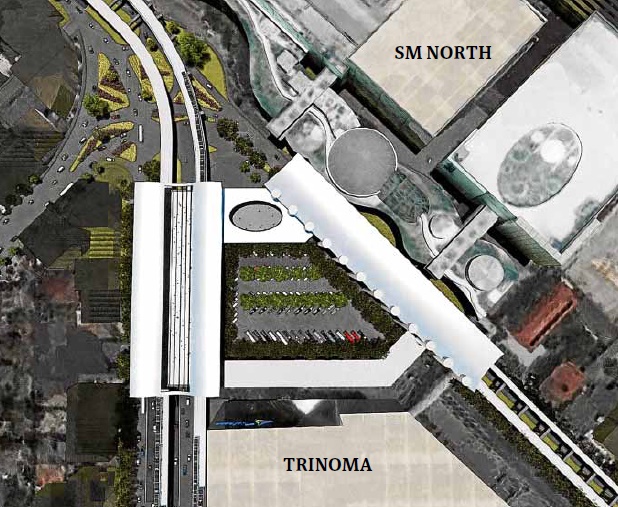
BREAKING GROUND Artist’s sketch of the railway common station that is expected to be constructed starting this December —CONTRIBUTED PHOTO
Concerned that the public will be shortchanged, a congressional inquiry will review a new P2.8-billion deal to construct the Philippine capital’s common train station, a project hobbled for eight years as two mall giants competed for its location and lucrative windfall from millions of commuters passing through the hub.
In a radio interview, Speaker Pantaleon Alvarez said on Thursday the House of Representatives would study the costs and benefits of the project in Quezon City to link up the Light Rail Transit (LRT) and Metro Rail Transit (MRT) systems to ensure that the riding public would be protected against big business interests.
Alvarez, sounding displeased by reports about the signing of a memorandum of agreement (MOA) on the project on Wednesday, said he did not consider it good news “because the cost [on the part of government] is too high.”
“The question now is this: Is the proposal for the common station really for the convenience of the passengers?” he said.
Alvarez said there should be safeguards to protect the government from additional financial burden as a result of the deal. “We will really be watching closely if this project is handled well,” he said.
Win-win?
On Wednesday, Transportation Secretary Arthur Tugade and Public Works Secretary Mark Villar, along with LRT Authority administrator Reynaldo Berroya, signed the MOA with the developers for the project.
Also present at the signing were SM Prime Holdings Inc. executive chair Hans Sy, Light Rail Manila Corp. vice chair Manuel V. Pangilinan, San Miguel Corp. president and chief operating officer Ramon Ang and Ayala Land Inc. vice chair Jaime Augusto Zobel de Ayala.
Among other concerns, Alvarez warned that the so-called “win-win” solution under the MOA would necessarily entail additional cost for the government.
“It’s only natural that you will adjust to what has been laid out for the project, so the government will shoulder a huge cost. So definitely, we will study this carefully and not allow that to happen,” Alvarez said.
The common station will rise on a 13,700-square-meter sprawl where Edsa adjoins North Avenue before Edsa turns sharply southward. The space, now used as a parking area, is between SM North Edsa and Trinoma malls.
The project will link MRT 3, LRT 1 and the MRT 7 train line from Quezon City to San Jose del Monte City in Bulacan by 2020.
Commuter comfort
The department said passenger convenience was the “prime” consideration for the project, saying that commuters transferring from MRT 3 to LRT 1 and MRT 7 will have to walk only 50 to 200 meters, depending on which train they use.
The government will spend P2.8 billion to build the portion that will house the platform and concourse of the LRT 1 and MRT 3 lines, of which a stretch spanning 1.2 kilometers has not been connected because of the dispute between SM and Ayala people on where the station should be built, oppressing commuters on either ends.
The dispute dates back to 2009, when SM Prime signed an agreement for the station to be built near the annex mall of SM City North Edsa and paid the government P200 million in the deal.
The project suffered delays after the Aquino administration decided in 2014 to move the location of the station to an area near Trinoma, saying this would bring the cost down to P1.4 billion. Critics said the move would entail long distance travel for commuters to change train lines.
SM sued and got a temporary restraining order from the Supreme Court. The project then went into a limbo, a hallmark of the ineptitude and neglect of the transport sector by the previous administration, according to critics.
Graft charge
Yesterday, former MRT 3 general manager Al Vitangcol told reporters he planned to file a graft complaint in connection with the Wednesday’s MOA, saying it violated the Government Procurement Reform Act.
He said the government’s move to appease both SM and Ayala officials “will be a very bad precedent.”
Vitangcol, who faces two graft cases for an alleged attempt to extort $30 million from a Czech train coach supplier, stressed that any procurement “should be done competitively.”
“But, this one, the other party who was not able to get the award entered into a compromise with the winning bidder,” he told reporters. “It will result in collusion.”
As a task force member that studied the plan, Vitangcol insisted that moving the common station in front of TriNoma is “actually not technically possible” as it carries the risk of accidents and incurs more expenses on the government’s part.
Vitangcol, an official in the Aquino administration under which the public transport system began to break down almost daily, said he was talking with other antigraft groups to prepare the case.